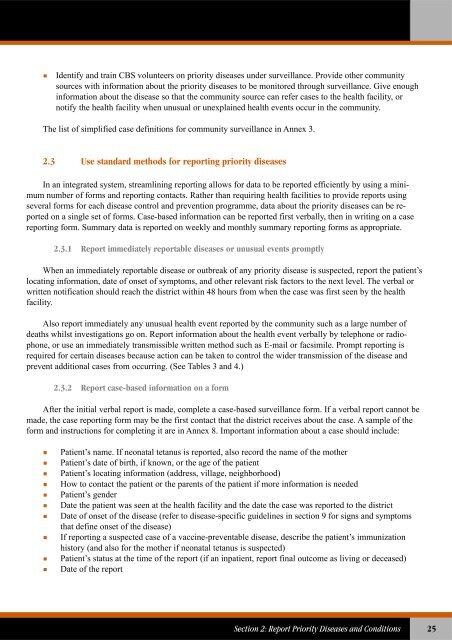Technical Guidelines for Integrated Disease Surveillance ... - PHRplus
Technical Guidelines for Integrated Disease Surveillance ... - PHRplus
Technical Guidelines for Integrated Disease Surveillance ... - PHRplus
You also want an ePaper? Increase the reach of your titles
YUMPU automatically turns print PDFs into web optimized ePapers that Google loves.
Identify and train CBS volunteers on priority diseases under surveillance. Provide other communitysources with in<strong>for</strong>mation about the priority diseases to be monitored through surveillance. Give enoughin<strong>for</strong>mation about the disease so that the community source can refer cases to the health facility, ornotify the health facility when unusual or unexplained health events occur in the community.The list of simplified case definitions <strong>for</strong> community surveillance in Annex 3.2.3 Use standard methods <strong>for</strong> reporting priority diseasesIn an integrated system, streamlining reporting allows <strong>for</strong> data to be reported efficiently by using a minimumnumber of <strong>for</strong>ms and reporting contacts. Rather than requiring health facilities to provide reports usingseveral <strong>for</strong>ms <strong>for</strong> each disease control and prevention programme, data about the priority diseases can be reportedon a single set of <strong>for</strong>ms. Case-based in<strong>for</strong>mation can be reported first verbally, then in writing on a casereporting <strong>for</strong>m. Summary data is reported on weekly and monthly summary reporting <strong>for</strong>ms as appropriate.2.3.1 Report immediately reportable diseases or unusual events promptlyWhen an immediately reportable disease or outbreak of any priority disease is suspected, report the patient’slocating in<strong>for</strong>mation, date of onset of symptoms, and other relevant risk factors to the next level. The verbal orwritten notification should reach the district within 48 hours from when the case was first seen by the healthfacility.Also report immediately any unusual health event reported by the community such as a large number ofdeaths whilst investigations go on. Report in<strong>for</strong>mation about the health event verbally by telephone or radiophone,or use an immediately transmissible written method such as E-mail or facsimile. Prompt reporting isrequired <strong>for</strong> certain diseases because action can be taken to control the wider transmission of the disease andprevent additional cases from occurring. (See Tables 3 and 4.)2.3.2 Report case-based in<strong>for</strong>mation on a <strong>for</strong>mAfter the initial verbal report is made, complete a case-based surveillance <strong>for</strong>m. If a verbal report cannot bemade, the case reporting <strong>for</strong>m may be the first contact that the district receives about the case. A sample of the<strong>for</strong>m and instructions <strong>for</strong> completing it are in Annex 8. Important in<strong>for</strong>mation about a case should include:Patient’s name. If neonatal tetanus is reported, also record the name of the motherPatient’s date of birth, if known, or the age of the patientPatient’s locating in<strong>for</strong>mation (address, village, neighborhood)How to contact the patient or the parents of the patient if more in<strong>for</strong>mation is neededPatient’s genderDate the patient was seen at the health facility and the date the case was reported to the districtDate of onset of the disease (refer to disease-specific guidelines in section 9 <strong>for</strong> signs and symptomsthat define onset of the disease)If reporting a suspected case of a vaccine-preventable disease, describe the patient’s immunizationhistory (and also <strong>for</strong> the mother if neonatal tetanus is suspected)Patient’s status at the time of the report (if an inpatient, report final outcome as living or deceased)Date of the reportSection 2: Report Priority <strong>Disease</strong>s and Conditions25















